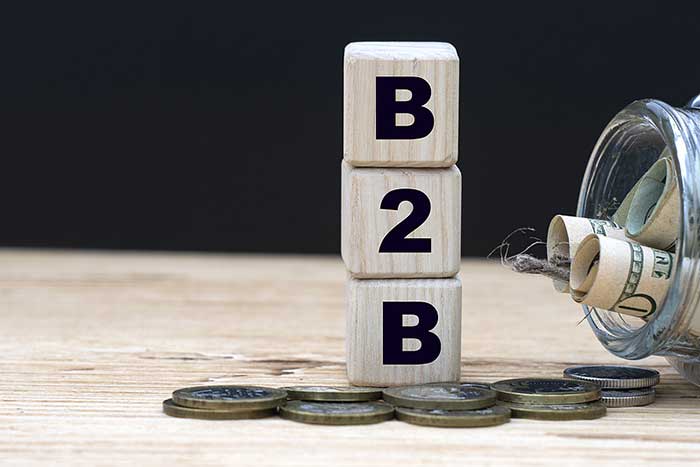The business world is always evolving and changing. As consumer needs change and businesses evolve, the need to reach a wider audience and expand your business significantly increases. Whether it’s e-commerce or a more traditional brick-and-mortar company, a quality B2B payment system helps accomplish these goals. Setting up a payment solution for your B2B business may seem daunting at first, but it’s actually fairly straightforward. After all, you want to ensure everyone gets paid, business operations don’t get interrupted, and your own business stays solvent. Don’t let B2B payment solutions hold back your success. Here’s a quick guide to getting started.

B2B Defined
B2B just means “business-to-business.” When one company supplies products and services to another company, that’s B2B in action. When the company sells items and services to consumers, it’s considered a business-to-consumer company. The success of B2B is in defining the right clientele and properly managing payments across all suppliers. A significant portion of Businesses in the United States fall into this category. For example, a retailer who purchases goods and products from a supplier for the purpose of reselling them in their store is a B2B business. B2B business models come in two types: vertical and horizontal. In vertical B2B, a company sells products within a single industry. In horizontal B2B, a company serves multiple industries.
Some of the highest volumes of B2B payments come from the following industries:
- Manufacturing – $3.53 trillion
- Professional and business services – $2.60 trillion
- Finance, insurance, real estate, rental, and leasing – $2.19 trillion
- Mining – $685 billion
- Wholesale trade – $643 billion
Now, your business may not be as large or extensive as some of these, but you still need to have a robust B2B payment system in place to handle everything from supplier payments to employee reimbursements at your organization.
Automate with software
Consider this significant, modern business problem: companies don’t automate, often relying on antiquated systems to reimburse employees and pay vendors. This unfortunate circumstance leads to additional payment problems down the line. Next thing you know, employees are furious over lost reimbursements, your suppliers are livid over missed payments and your customers are losing money at their own organizations due to issues related to those same ancient systems. While this is obviously an extreme case, it underscores the need for a better B2B payment automation solution to reduce costs and promote better efficiency. Automated B2B payments are the ideal solution. Payments can be spread out across multiple systems or be missed due to outdated processes. With automated B2B payment management, everything can be collected, assessed, and paid from a single place. It’s also integrated with your organization’s bank, so all payments will flow through a single portal rather than several different websites, uploads/downloads, or multiple channels.
Advantages of setting up automated B2B payment systems
Let’s face it: cutting paper checks is a pain in the neck. Setting up some form of oversight with your B2B systems is never a bad business move. First and foremost, it can prevent late payments. Most B2B invoices take about 35 days to get paid, with around 47% paid out late. Conversely, automation can not only prevent (or at least mitigate) late payments but provide some excellent key benefits for your organization. These include the following:
- Better liquidity for your organization
- Less supplier onboarding
- Reduced processing time
- Fraud prevention
- Paperwork reduction
- Convenience
- Accessibility
- Reduced risk
- Digital transactions/virtual payment cards
- More payment options for suppliers
All of these help improve cash flow and make all parties happy as you successfully conduct your own B2B operations.
Upgrade your spend management and visibility by digitizing payments
Spend management and visibility are incredibly important vectors in ruining your business. B2B payment software helps provide key insights into the entire payout process. Data insight makes it easier to reconcile accounts across multiple payment methods – including digital payments – invoices and purchase orders. Employees can process the information faster while giving suppliers/buyers more flexibility in receiving/making payments. Another method for managing spend and digitizing payments is to use virtual payment cards. Virtual payment cards are single-use, 16-digit cards intended for use in B2B payments and incorporated into the accounts payable process. They offer numerous advantages over paper checks or any transaction requiring another business to expose their bank account details to your business. as part of a robust B2B payment solution, virtual payment cards can provide superb return of investment for both parties involved. Various validation methods also help prevent fraud across the organization.
Look for rebates and cost reduction opportunities
A core value of any good B2B solution is the opportunity for reducing costs and taking full advantage of any available discounts or rebates. Fully automating and streamlining payments can occasionally help you acquire rebates or reduce costs. It’s also easier to fully reimburse employees for any business-related expenses they may incur. At the end of the day, the time savings alone can be reinvested into other areas of your operation effectively generating better success in the future.
